This information comes straight from my friends at US Inspect (you can read the original article here)
—–
Got the urge to plant and landscape?
Be very careful…what you don’t know could damage your property!
The law of unintended consequences, which applies to life in general, applies to landscaping in particular. In other words, planting over here could mean trouble over there.
We’ve delivered over 1 million home inspections over the last 30+ years – here are some simple landscaping do’s and don’ts that we’ve compiled from our inspection data.
Do: Plan ahead.
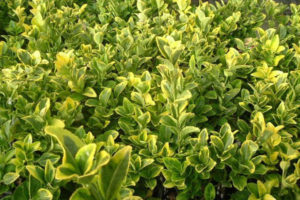
Planting is like life – planning for anything is always the preferable approach. If your landscaping dreams include planting new trees or shrubs near to your house, planning ahead is especially important.
Plants, shrubs, and trees are lovely additions to your property, but be aware that every plant and tree is different and has different needs in order to thrive. Most importantly, every plant has unique requirements for space, including room to grow.
Don’t: Plant shrubs too close to the house.
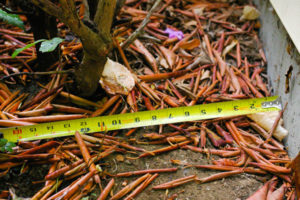
Avoid planting shrubs too close to your home, not just because plants will come into contact with and damage the siding, but because shrubs retain moisture.
- Moisture deteriorates exterior cladding – The single biggest issue with regards to shrubbery growing near or on the structure is moisture, which will accelerate deterioration of practically any type of exterior cladding.
- Moisture attracts termites – Moisture is the #1 “conducive condition” for termite infestations. Plants are organic “cellulose-based” organisms. Guess what termites eat? Cellulose-based organisms. While termites are mostly interested in dead wood (building materials), termites can also attack roots of live shrubs and trees. Therefore, whenever you plant anything close to the structure, you must consider the possibility that you may be planting termite food right next to your house. Termites are migratory – if they attack trees or shrubs near your house, guess where they’re headed next?
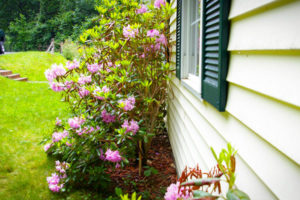
Baby shrubs grow into monster shrubs. What claims to be a dwarf shrub or mini crepe myrtle today could be a shade tree in the blink of an eye.
You’ve seen them – houses covered with what once were baby shrubs. You need to account for adult sizes when choosing a location on your property. And don’t believe the plastic tags. If a vendor claims that a shrub will be 24″ tall, expect it to grow to be twice that size.
If shrubs grow more than you initially anticipated, trim the shrubs regularly – there should be at least 1′ of space between shrubs and the exterior of the structure.
Do: Check your slope.
“Grading” describes surface elevation changes when compared to other areas around or near the house. Proper grading is when the grade or slope of the elevation slopes downward and away from the home at a rate of 1″ per foot for the first 6′ and then a continued slope for at least 10′ from the foundation.
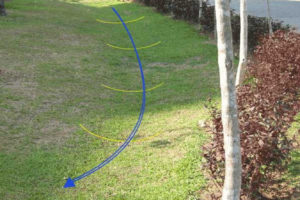
If the elevation looks flat or worse, slopes back towards the house, you have work to do before planting new anythings.
Grading should also ensure that water flows away from the house; if the grading near the house is OK but there’s a flood in the yard every time it rains, even the best near-home grading won’t prevent water intrusion.
Don’t: Plant trees too close to the house.
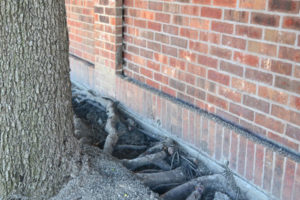
As bad as it is to plant shrubs too close to the house, you’re risking disaster if you plant trees too close to the house.
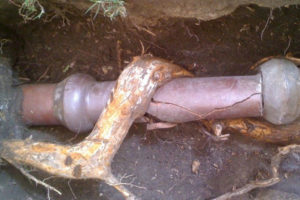
- Structural damage – Tree roots can cause structural damage to your home depending on the proximity and type of tree. Ficus trees, for example, have very aggressive root systems and even a small ficus tree planted close to a structure could cause foundation damage. Oaks and maples have massive root systems, but actually may cause less damage because their roots generally go around obstructions rather than through them.
- Plumbing damage – Tree roots can also sometimes cause plumbing problems. Aggressive root systems bore through older, brittle plumbing components like cast iron and clay that are under the structure; large roots can actually crush plumbing components. Our Sewer Scope Inspection often reveals infiltration of root systems blocking drainage in municipal systems as well as septic systems, repairs of which can be very costly.
- Roofing damage – Tree limbs which stretch over your house are accidents waiting to happen. But even if that old walnut tree stays upright for 100 years, contact with branches and debris from the leaves and small sticks will gradually and prematurely wear away your roof covering.
- Heaving damage – Tree roots can damage walkways and driveways. Root systems that heave walkways and driveways not only cause concrete and asphalt damage, but also create a “trip hazard” due to uneven surfaces.
Give trees 15′ to 20′ space from the structure.
Talk to your local nursery professional if you want to learn more about the various root systems. Or check out The Right Tree in the Right Place at the Arbor Day Foundation.
Do: Ensure proper drainage.
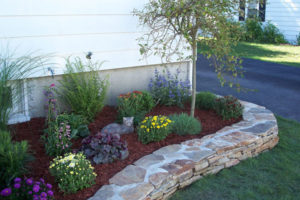
The best way to avoid structural deterioration from water is to keep the dwelling dry. Landscaping is an important component to help achieve a dry house. Planting according to area-specific types and species will help to ensure that excess water will be soaked up by plants, shrubs, trees, and lawn. Properties with poorly maintained landscaping are more susceptible to water penetration issues.
Installing barriers (retaining walls, landscaping timbers, vertical plastic edging, stones) can exacerbate the problem because barriers don’t just hold flowers and mulch – barriers block drainage. If you prefer to use landscape timbers and edging, make sure downspouts extend beyond the barriers. If your home is in cold climes, don’t direct downspouts onto the driveway and/or sidewalks; snow and freezing rain can make the walking areas unsafe and help to accelerate cracks in the driveway and/or sidewalk.


 Facebook
Facebook
 X
X
 Pinterest
Pinterest
 Copy Link
Copy Link


